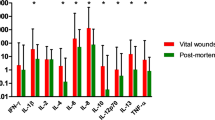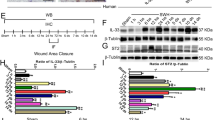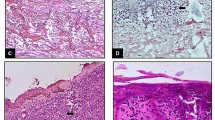Abstract
We performed quantification of IL 2, IL 4, IL 6, IL 8, IL 10, GM-CSF, IFN γ, and TNF α in human dermal wounds for wound age estimation. The proliferation of dermal cells and infiltration of inflammatory cells were also analyzed. Neutrophils and macrophages were detected from 2 h post-injury, and strong infiltrations were seen at 33–49 h. T and B lymphocytes also infiltrated simultaneously from 71 h. Strong proliferation of fibroblasts were shown from 246 h, and thickening of the epidermis from 71 h. IL 10, GM-CSF, IFNγ, and TNF α increased from the early phase of dermal wound healing, IL 6 exclusively in the middle phase, IL 2, IL 4, and IL 8 from the middle phase to the late phase. Among the cytokines analyzed in the present study, IL 6, IL 8, IFNγ, and TNF α were strongly expressed. Results of the present study suggest that multiplex cytokine analysis at the wound site can be useful for wound age estimation. In addition, multiplex data obtained from the same sample with a single method would demonstrate more accurate interactions of cytokines during dermal wound healing. Although the present study was oriented to practical forensic pathology, the data obtained would be informative for various fields of medicine.

Similar content being viewed by others
References
Betz P (1994) Histological and enzyme histochemical parameters for the age estimation of human skin wounds. Int J Legal Med 107:60–68
Bradford MM (1976) A rapid and sensitive method for the quantitation of microgram quantities of protein utilizing the principle of protein-dye binding. Anal Biochem 72:248–254
Breuhahn K, Mann A, Muller G et al (2000) Epidermal overexpression of granulocyte-macrophage colony-stimulating factor induces both keratinocyte proliferation and apoptosis. Cell Growth Differ 11:111–121
Bussolino F, Wang JM, Defilippi P et al (1989) Granulocyte- and granulocyte-macrophage-colony stimulating factors induce human endothelial cells to migrate and proliferate. Nature 337:471–473
Castells-Rodellas A, Castell JV, Ramirez-Bosca A et al (1992) Interleukin-6 in normal skin and psoriasis. Acta Derm Venereol 72:165–168
Dedhar S, Gaboury L, Galloway P et al (1988) Human granulocyte-macrophage colony-stimulating factor is a growth factor active on a variety of cell types of nonhemopoietic origin. Proc Natl Acad Sci USA 85:9253–9257
Fertin C, Nicolas JF, Gillery P et al (1991) Interleukin-4 stimulates collagen synthesis by normal and scleroderma fibroblasts in dermal equivalents. Cell Mol Biol 37:823–829
Gillitzer R, Goebeler M (2001) Chemokines in cutaneous wound healing. J Leukoc Biol 69:513–521
Hayashi T, Ishida Y, Kimura A et al (2004) Forensic application of VEGF expression to skin wound age determination. Int J Legal Med 118:320–325
Hernandez-Cueto C, Girela E, Sweet DJ (2000) Advances in the diagnosis of wound vitality: a review. Am J Forensic Med Pathol 21:21–31
Ishida Y, Kondo T, Takayasu T et al (2004) The essential involvement of cross-talk between IFN-gamma and TGF-beta in the skin wound-healing process. J Immunol 172:1848–1855
Kirnbauer R, Kock A, Schwarz T et al (1989) IFN-beta 2, B cell differentiation factor 2, or hybridoma growth factor (IL-6) is expressed and released by human epidermal cells and epidermoid carcinoma cell lines. J Immunol 142:1922–1928
Kock A, Schwarz T, Kirnbauer R et al (1990) Human keratinocytes are a source for tumor necrosis factor alpha: evidence for synthesis and release upon stimulation with endotoxin or ultraviolet light. J Exp Med 172:1609–1614
Kondo T, Ohshima T (1996) The dynamics of inflammatory cytokines in the healing process of mouse skin wound: a preliminary study for possible wound age determination. Int J Leg Med 108:231–236
Kondo T, Ohshima T, Mori R et al (2002) Immunohistochemical detection of chemokines in human skin wounds and its application to wound age determination. Int J Leg Med 116:87–91
Kondo T (2007) Timing of skin wounds. Legal Med 9:109–114
Kowanko IC, Ferrante A (1987) Stimulation of neutrophil respiratory burst and lysosomal enzyme release by human interferon-gamma. Immunology 62:149–151
Li J, Ireland GW, Farthing PM et al (1996) Epidermal and oral keratinocytes are induced to produce RANTES and IL-8 by cytokine stimulation. J Invest Dermatol 106:661–666
Malek TR (2003) The main function of IL-2 is to promote the development of T regulatory cells. J Leukoc Biol 74:961–965
Nathan CF, Murray HW, Wiebe ME et al (1983) Identification of interferon-gamma as the lymphokine that activates human macrophage oxidative metabolism and antimicrobial activity. J Exp Med 158:670–689
Newman SL, Henson JE, Henson PM (1982) Phagocytosis of senescent neutrophils by human monocyte-derived macrophages and rabbit inflammatory macrophages. J Exp Med 156:430–442
Ohshima T (2000) Forensic wound examination. Forensic Sci Int 113:153–164
Ohshima T, Sato Y (1998) Time-dependent expression of interleukin-10 (IL-10) mRNA during the early phase of skin wound healing as a possible indicator of wound vitality. Int J Leg Med 111:251–255
Ortiz-Rey JA, Suarez-Penaranda JM, Da Silva EA et al (2002) Immunohistochemical detection of fibronectin and tenascin in incised human skin injuries. Forensic Sci Int 126:118–122
Paquet P, Pierard GE (1996) Interleukin-6 and the skin. Int Arch Allergy Immunol 109:308–317
Rennekampff HO, Hansbrough JF, Kiessig V et al (2000) Bioactive interleukin-8 is expressed in wounds and enhances wound healing. J Surg Res 93:41–54
Schroder JM (1995) Cytokine networks in the skin. J Invest Dermatol 105:20S–24S
Seitz M, Loetscher P, Dewald B et al (1995) Interleukin-10 differentially regulates cytokine inhibitor and chemokine release from blood mononuclear cells and fibroblasts. Eur J Immunol 25:1129–1132
Sticherling M, Hetzel F, Schroder JM et al (1993) Time- and stimulus-dependent secretion of NAP-1/IL-8 by human fibroblasts and endothelial cells. J Invest Dermatol 101:573–576
Strieter RM, Kasahara K, Allen RM et al (1992) Cytokine-induced neutrophil-derived interleukin-8. Am J Pathol 141:397–407
Takamiya M, Saigusa K, Nakayashiki N et al (2003) Studies on mRNA expression of basic fibroblast growth factor in wound healing for wound age determination. Int J Leg Med 117:46–50
Takamiya M, Kumagai R, Nakayashiki N et al (2006) A study on mRNA expressions of fibronectin in dermal and cerebral wound healing for wound age estimation. Legal Med 8:214–219
Wanidworanun C, Strober W (1993) Predominant role of tumor necrosis factor-alpha in human monocyte IL-10 synthesis. J Immunol 151:6853–6861
Wilkinson PC, Newman I (1992) Identification of IL-8 as a locomotor attractant for activated human lymphocytes in mononuclear cell cultures with anti-CD3 or purified protein derivative of Mycobacterium tuberculosis. J Immunol 149:2689–2694
Acknowledgment
This study was supported by grants-in-aid for health care research from Iwate prefecture, Japan.
Author information
Authors and Affiliations
Corresponding author
Rights and permissions
About this article
Cite this article
Takamiya, M., Fujita, S., Saigusa, K. et al. Simultaneous detection of eight cytokines in human dermal wounds with a multiplex bead-based immunoassay for wound age estimation. Int J Legal Med 122, 143–148 (2008). https://doi.org/10.1007/s00414-007-0183-5
Received:
Accepted:
Published:
Issue Date:
DOI: https://doi.org/10.1007/s00414-007-0183-5




